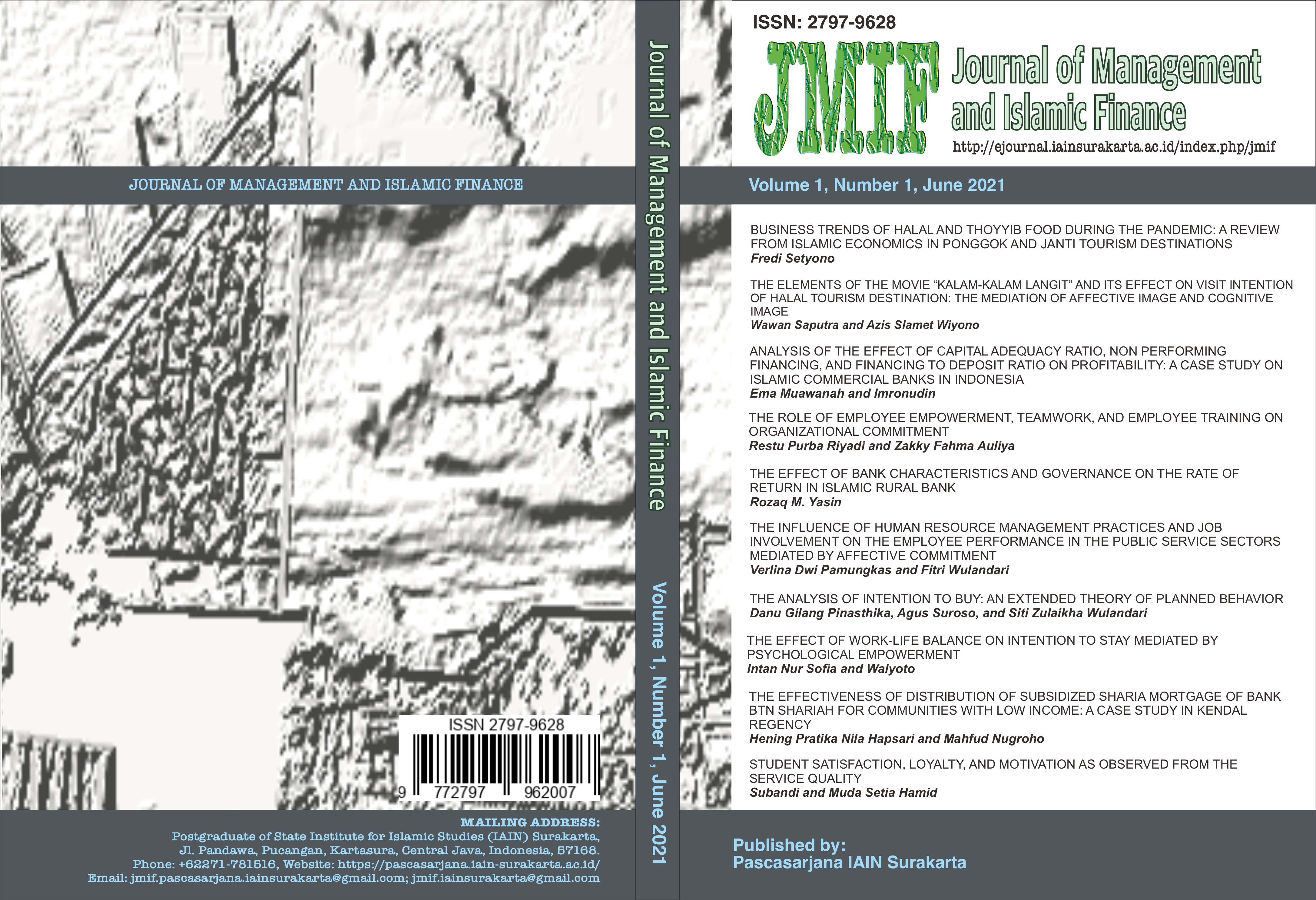THE INFLUENCE OF HUMAN RESOURCE MANAGEMENT PRACTICES AND JOB INVOLVEMENT ON THE EMPLOYEE PERFORMANCE IN THE PUBLIC SERVICE SECTORS MEDIATED BY AFFECTIVE COMMITMENT
DOI:
https://doi.org/10.22515/jmif.v1i1.3571Abstract
Downloads
References
Anvari, R., Mansor, N. N. A., Rahman, S. A. B. P. A., Rahman, R. H. B. A., & Chermahini, S. H. (2014). Mediating effects of affective organizational commitment and psychological contract in the relationship between strategic compensation practices and knowledge sharing. Procedia - Social and Behavioral Sciences, 129, 111–118.
Brzeziński, S., & Bąk, A. (2015). Management of employees’ commitment in the process of organization transformation. Procedia Economics and Finance, 27(15), 109–115.
Dabale, W. P., Jagero, N., & Nyauchi, M. (2014). The Relationship between Training and Employee Performance: The Case of Mutare City Council, Zimbabwe. International Journal of Human Resource Studies, 4(4), 61. https://doi.org/10.5296/ijhrs.v4i4.6620
Delery, J., & Gupta, N. (2016). Human resource management practices and organizational effectiveness: internal fit matters. Journal of Organizational Effectiveness, 3(2), 139–163. https://doi.org/10.1108/JOEPP-03-2016-0028
Diaz-Fernandez, M., Bornay-Barrachina, M., & Lopez-Cabrales, A. (2017). HRM practices and innovation performance: a panel-data approach. International Journal of Manpower, 38(3), 354–372. https://doi.org/10.1108/IJM-02-2015-0028
Folorunso, O. O., Adewale, A. J., & Abodunde, S. M. (2014). Exploring the Effect of Organizational Commitment Dimensions on Employees Performance: An Empirical Evidence from Academic Staff of Oyo State Owned Tertiary Institutions, Nigeria. International Journal of Academic Research in Business and Social Sciences, 4(8), 275.
Freese, M., & Fay, D. (2001). Personal initiative (PI): An active performance concept for work in the 21st century. Research in Organizational Behavior, 23, 133–187.
Gahlawat, N., & Kundu, S. C. (2019). Participatory HRM and firm performance: Unlocking the box through organizational climate and employee outcomes. Employee Relations, 41(5), 1098–1119. https://doi.org/10.1108/ER-05-2018-0147
Hermawati, A., & Mas, N. (2017). Mediation effect of quality of worklife, job involvement, and organizational citizenship behavior in relationship between transglobal leadership to employee performance. International Journal of Law and Management, 59(6), 1143–1158. https://doi.org/10.1108/IJLMA-08-2016-0070
Kamuri, K. J. (2017). Electronic Human Resource Management: inovasi pengelolaan sumber daya manusia dalam organisasi (analisis penerapan e-HRM pada PT Telkom wilayah Kupang-NTT). Journal of Management, 4(1), 33–52.
Kitchot, S., Siengthai, S., & Sukhotu, V. (2020). The mediating effects of HRM practices on the relationship between SCM and SMEs firm performance in Thailand. Supply Chain Management, 26(1), 87–101. https://doi.org/10.1108/SCM-05-2019-0177
Mardatillah, Y., Nasution, H., & Ishak, A. (2013). Evaluasi kinerja manajemen sumber daya manusia PT. Bank XYZ dengan human resource scorecard. Jurnal Teknik Industri USU, 1(1), 23–27.
Memon, M. A., Salleh, R., Mirza, M. Z., Cheah, J. H., Ting, H., Ahmad, M. S., & Tariq, A. (2020). Satisfaction matters: the relationships between HRM practices, work engagement and turnover intention. International Journal of Manpower, 42(1), 21–50. https://doi.org/10.1108/IJM-04-2018-0127
Moideenkutty, U., Al-Lamki, A., & Murthy, Y. S. R. (2011). HRM practices and organizational performance in Oman. Personnel Review, 40(2), 239–251. https://doi.org/10.1108/00483481111106101
Muma, M., Iravo, D. A., & Omondi, D. M. (2014). Effect of training needs assessment on employee commitment in public Universities: A case study of Jomo Kenyatta University of Agriculture and Technology. International Journal of Academic Research in Business and Social Sciences, 4(9), 233–250. https://doi.org/10.6007/ijarbss/v4-i9/1153
Nasurdin, A. M., Ahmad, N. H., & Tan Cheng Ling. (2015). High performance human resource practices, identification with organizational values and goals, and service-oriented organizational citizenship behavior: a review of literature and proposed model. SHS Webof Conferences, 1–15.
fOvt,cen, E., Francis, K., & Angundaru, G. (2017). The role of training in building employee commitment: the mediating effect of job satisfaction. European Journal of Training and Development, 41(9), 742–757. https://doi.org/10.1108/EJTD-11-2016-0084
Panjaitan, M. (2018). Peran keterlibatan dan partisipasi karyawan terhadap kinerja karyawan. Jurnal Manajemen, 4(1), 52–60.
Paolillo, A., Platania, S., Magnano, P., & Ramaci, T. (2015). Organizational Justice, Optimism and Commitment to Change. Procedia - Social and Behavioral Sciences, 191, 1697–1701. https://doi.org/10.1016/j.sbspro.2015.04.479
Rotenberry, P. F., & Moberg, P. J. (2007). Assessing the impact of job involvement on performance. Management Research News, 30(3), 203–215. https://doi.org/10.1108/01409170710733278
Şendoğdu, A. A., Kocabacak, A., & Güven, Ş. (2013). The Relationship between Human Resource Management Practices and Organizational Commitment: A Field Study. Procedia - Social and Behavioral Sciences, 99, 818–827. https://doi.org/10.1016/j.sbspro.2013.10.553
Sonnentag, S. (2002). Performance Concepts and Performance Theory. Psychological Management of Individual Performance., 23(1), 3–25.
Tri Wikaningrum. (2011). Praktek dan Kebijakan Manajemen Sumber Daya Manusia Pada Perbankan Syariah. Jurnal Siasat Bisnis, 15(1), 99–123.
Van, D. L., & LePine, J. A. (1998). Helping and voice extra-role behaviors: Evidence of construct and predictive validity. Academy of Management Journal, 41(1), 108–119.
Wulandari, F., Ferdinand, A. T., & Dwiatmadja, C. (2018). Knowledge sharing in a critical moment of work: A driver for success? International Journal of Knowledge Management, 14(2), 88–98. https://doi.org/10.4018/IJKM.2018040106
Wulandari, F., & Putriyanti, O. A. (2020). Studi share leadership dan perannya dalam meningkatkan kinerja karyawan. Jurnal Bisnis Dan Manajemen, 7(2), 74–84. http://jurnal.unmer.ac.id/index.php/jbm/article/view/4076
Zhang, F., Zhu, L., & Wei, L. (2020). Shareholder involvement and firm innovation performance: Empirical evidence from Chinese firms. Chinese Management Studies, 14(3), 833–855. https://doi.org/10.1108/CMS-01-2019-0029
Downloads
Published
Issue
Section
Citation Check
License
Copyright (c) 2021 Journal of Management and Islamic Finance

This work is licensed under a Creative Commons Attribution-ShareAlike 4.0 International License.
Authors who publish with this journal agree to the following terms:
- Authors retain copyright and grant the journal right of first publication with the work simultaneously licensed under a Creative Commons Attribution License that allows others to share the work with an acknowledgement of the work's authorship and initial publication in this journal.
- Authors are able to enter into separate, additional contractual arrangements for the non-exclusive distribution of the journal's published version of the work (e.g., post it to an institutional repository or publish it in a book), with an acknowledgement of its initial publication in this journal.
- Authors are permitted and encouraged to post their work online (e.g., in institutional repositories or on their website) prior to and during the submission process, as it can lead to productive exchanges, as well as earlier and greater citation of published work.






